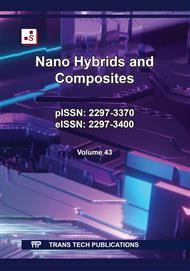[1]
A. Shakeel, K. Rizwan, U. Farooq, S. Iqbal, and A. Ali, Chemosphere Advanced polymeric/inorganic nanohybrids : An integrated platform for gas sensing applications, Chemosphere. 294 (2022) 133772.
DOI: 10.1016/j.chemosphere.2022.133772
Google Scholar
[2]
H.Y. Li, S.N. Zhao, S.Q. Zang, and J. Li, Functional metal-organic frameworks as effective sensors of gases and volatile compounds, Chem. Soc. Rev. 49 (17) (2020) 6364–6401.
DOI: 10.1039/c9cs00778d
Google Scholar
[3]
Z. Li, J. Chen, L. Chen, M. Guo, Y. Wu, Y. Wei, J. Wang, and X. Wang, Hollow Au/Polypyrrole Capsules to Form Porous and Neural Network-Like Nanofibrous Film for Wearable, Super-Rapid, and Ultrasensitive NH3 Sensor at Room Temperature, ACS Appl. Mater. Interfaces. 12 (49) (2020) 55056–55063.
DOI: 10.1021/acsami.0c15585
Google Scholar
[4]
S. Giddey, S.P.S. Badwal, and A. Kulkarni, Review of electrochemical ammonia production technologies and materials, Int. J. Hydrogen Energy. 38(34) (2013) 14576–14594.
DOI: 10.1016/j.ijhydene.2013.09.054
Google Scholar
[5]
V. Talwar, O. Singh, and R.C. Singh, ZnO assisted polyaniline nanofibers and its application as ammonia gas sensor, Sens. Actuators, B. 191 (2014) 276–282.
DOI: 10.1016/j.snb.2013.09.106
Google Scholar
[6]
G.K. Mani and J.B.B. Rayappan, A highly selective and wide range ammonia sensor - Nanostructured ZnO: Co thin film, Materials Science and Engineering B: Solid-State Materials for Advanced Technology. 191(C) (2015) 41–50.
DOI: 10.1016/j.mseb.2014.10.007
Google Scholar
[7]
H. Tai, S. Wang, Z. Duan, and Y. Jiang, Evolution of breath analysis based on humidity and gas sensors: Potential and challenges, Sens. Actuators, B. 318 (2020) 128104.
DOI: 10.1016/j.snb.2020.128104
Google Scholar
[8]
A. Haynes and P. Gouma, Polyaniline-based environmental gas sensors, M-I. Baraton (ed.), Sensors for Environment, Health and Security, Springer Science Business Media, (2009) p.451–459.
DOI: 10.1007/978-1-4020-9009-7_30
Google Scholar
[9]
A.H. Al-Husseini, A.M.A. Al-Sammarraie, and W.R. Saleh, Specific NH3 Gas Sensor Worked at Room Temperature Based on MWCNTs-OH Network, Nano Hybrids and Composites. 23 (2018) 8–16.
DOI: 10.4028/www.scientific.net/nhc.23.8
Google Scholar
[10]
M.B. Regasa, O.E. Femi, T.R. Soreta, P.C. Ramamarthy, and S. Kumaran, Development of Melamine Electrochemical Sensor Using Molecularly Imprinted Conducting Polyanilne-Oxalic Acid Blend as a Molecular Recognition Element, Nano Hybrids and Composites. 29 (2020) 61–73.
DOI: 10.4028/www.scientific.net/nhc.29.61
Google Scholar
[11]
N. Guo, H. Tai, Z. Ye, and G. Xie, In Situ Self-Assembled Graphene-Polyaniline Nanocomposite Thin Films for Ammonia Gas Sensor, Advanced Materials Research. 998–999 (2014) 63–66.
DOI: 10.4028/www.scientific.net/amr.998-999.63
Google Scholar
[12]
K. Kan, C. Chen, G. Zhang, C. Jiang, L. Li, and K. Shi, Fabrication of Polyaniline-Coated Carbon Nanotubes Conducting Wire Nanocomposite for NH3 Gas Sensors at Room Temperature, Advanced Materials Research. 554–556 (2012) 661–666.
DOI: 10.4028/www.scientific.net/amr.554-556.661
Google Scholar
[13]
S. Pandey, Highly sensitive and selective chemiresistor gas/vapor sensors based on polyaniline nanocomposite: A comprehensive review, J. Sci.: Adv. Mater. Devices. 1(4) (2016) 431–453.
DOI: 10.1016/j.jsamd.2016.10.005
Google Scholar
[14]
E.N. Zare, P. Makvandi, F. Rossi, A. Motahari, and G. Perale, Progresses in conductive polyaniline-based nanocomposites for biomedical applications : A review, J. Med. Chem. 63(1) (2019) 1–22.
DOI: 10.1021/acs.jmedchem.9b00803
Google Scholar
[15]
A.L. Kukla, Y.M. Shirshov, and S.A. Piletsky, Ammonia sensors based on sensitive polyaniline films, Sens. Actuators B: Chem 37 (1996) 135–140.
DOI: 10.1016/s0925-4005(97)80128-1
Google Scholar
[16]
S. Sankar and M.T. Ramesan, Synthesis, characterization, conductivity and gas sensing performance of copolymer nanocomposites based on copper alumina and poly (aniline-co-pyrrole), Polym. Eng. Sci. (2022).
DOI: 10.21203/rs.3.rs-1484974/v1
Google Scholar
[17]
A.A. Athawale, S.V. Bhagwat, and P.P. Katre, Nanocomposite of Pd–polyaniline as a selective methanol sensor, Sensors and Actuators B: 114 (2006) 263–267.
DOI: 10.1016/j.snb.2005.05.009
Google Scholar
[18]
N.G. Deshpande, Y.G. Gudage, R. Sharma, J.C. Vyas, J.B. Kim and Y.P. Lee, Studies on tin oxide-intercalated polyaniline nanocomposite for ammonia gas sensing applications, Sens. Actuators, B. 138(1) (2009) 76–84.
DOI: 10.1016/j.snb.2009.02.012
Google Scholar
[19]
H. Shiigi, T. Oho, T. Tonosaki, and K. Ogura, CO2-sensitive characteristics of base-type polyaniline/poly(vinyl alcohol) composites at room temperature and effects of coexisting gases, Electrochemistry. 69(12) (2001) 997–1001.
DOI: 10.5796/electrochemistry.69.997
Google Scholar
[20]
Q. Wu, W. Shen, D. Lv, W. Chen, W. Song, and R. Tan, An enhanced flexible room temperature ammonia gas sensor based on GP-PANI / PVDF multi-hierarchical nanocomposite film, Sens. Actuators, B. 334 (2021) 129630.
DOI: 10.1016/j.snb.2021.129630
Google Scholar
[21]
G. Fan, D. Chen, T. Li, S. Yi, H. Ji, Y. Wang, Z. Zhang, G. Shao, B. Fan, H. Wang, H. Xu, H. Lu, Y. Zhou, R. Zhang, and J. Sun, Enhanced room-temperature ammonia-sensing properties of polyaniline-modified WO3 nanoplates derived via ultrasonic spray process, Sens. Actuators, B. 312 (2020) 127892.
DOI: 10.1016/j.snb.2020.127892
Google Scholar
[22]
F.A. Tabar, A. Nikfarjam, N. Tavakoli, J.N. Gavgani, and M. Mahyari, Chemical-resistant ammonia sensor based on polyaniline/CuO nanoparticles supported on three-dimensional nitrogen-doped graphene-based framework nanocomposites, Microchim. Acta. 5(167) (2020) 1–13.
DOI: 10.1007/s00604-020-04282-y
Google Scholar
[23]
F.S. Hadano, A.E.X. Gavim, J.C. Stefanelo, S.L. Gusso, A.G. Macedo, P.C. Rodrigues, A.R.B. Mohd Yusoff, F.K. Schneider, J.F.D. Deus, and W. José da Silva, NH3 Sensor Based on rGO-PANI Composite with Improved Sensitivity, Sensors. 21 (2021) 4947.
DOI: 10.3390/s21154947
Google Scholar
[24]
A. Liu, S. Lv, L. Jiang, F. Liu, L. Zhao, J. Wang, X. Hu, Z. Yang, J. He, C. Wang, X. Yan, P. Sun, K. Shimanoe, and G. Lu, The gas sensor utilizing polyaniline/ MoS2 nanosheets/SnO2 nanotubes for the room temperature detection of ammonia, Sens. Actuators, B. 332 (2021) 129444.
DOI: 10.1016/j.snb.2021.129444
Google Scholar
[25]
S. Li, P. Lin, L. Zhao, C. Wang, D. Liu, F. Liu, P. Sun, X. Liang, F. Liu, X. Yan, Y. Gao and G. Lu, The room temperature gas sensor based on Polyaniline@flower-like WO3 nanocomposites and flexible PET substrate for NH3 detection, Sens. Actuators, B. 259 (2018) 505–513.
DOI: 10.1016/j.snb.2017.11.081
Google Scholar
[26]
G. Luo, L. Xie, M. He, R. Jaisutti and Z. Zhu, Flexible fabric gas sensors based on reduced graphene-polyaniline nanocomposite for highly sensitive NH3 detection at room temperature, Nanotechnology. 32(30) (2021) 305501.
DOI: 10.1088/1361-6528/abf455
Google Scholar


